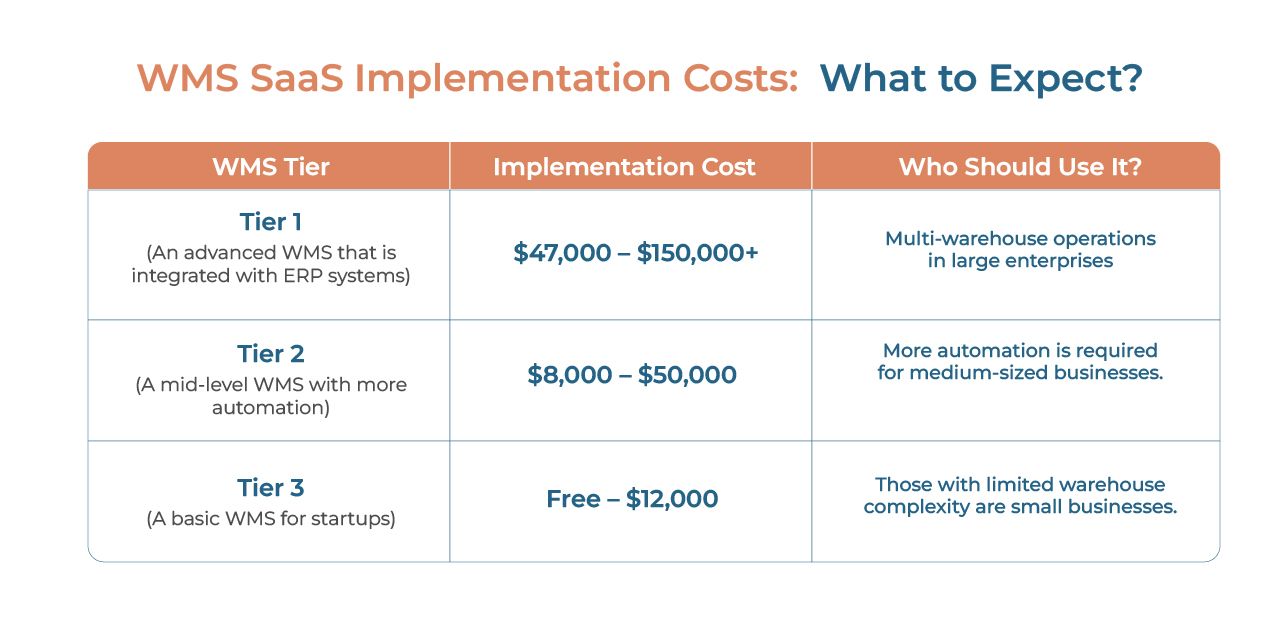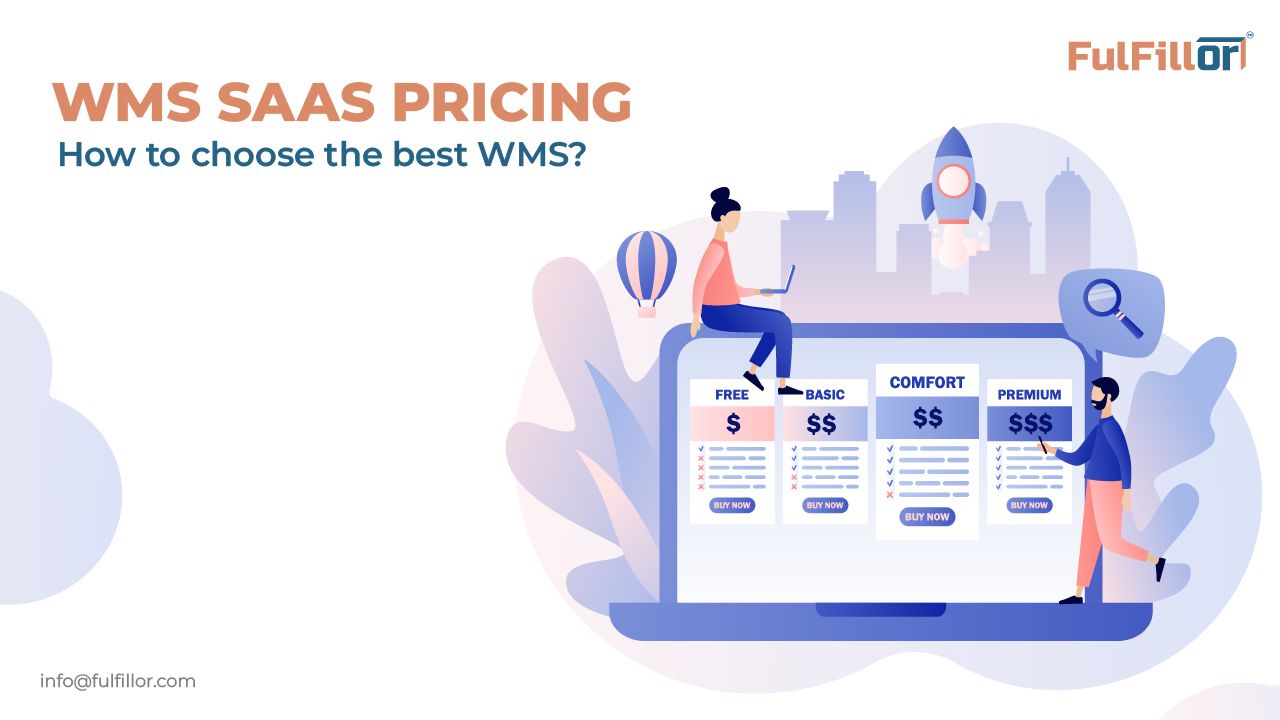A Comprehensive Guide to WMS SaaS Pricing: How to Choose a Top-Performing WMS Solution?
Planning to invest in a dedicated Warehouse management system in the US but worried about its costs? Do you know that 80% of warehouses are still unknowingly operating on manual processes, affecting productivity, growth, and inflating costs? With current advancements in technology, you need a smart, all-in-one warehouse management solution that helps businesses reduce operating costs by as much as 30%.
Modern WMS solutions operate on cloud-based SaaS models, leading to varying pricing structures. But don’t worry—we’ve got you covered. In this guide, we’ll break down the ins and outs of SaaS WMS pricing, outline the key factors to consider, and help you choose the best warehouse management solution for your business. So, Let’s dive in!
Understanding SaaS WMS Pricing Models and Choosing the Right Plan for Your Business!

The ideal Warehouse Management System SaaS pricing model depends on various factors such as size of the business, the level of business turnover, and the degree of feature complexity. Below is the list of the most popular pricing strategies that businesses are currently using:
1. Subscription-Based Pricing
Within this popular pricing model, companies make recurring payments for the use of the services on a monthly or annual basis. Another name for this model is a consumption-based model which involves:
-
Per User Model – This model charges a monthly or annual fee based on the number of users. Suitable for companies with a fixed but small workforce.
-
Per Feature Model – This price model is determined by the functionalities Are you planning choose including basic inventory management or advanced AI-assisted controls.
2. Volume-Based Pricing
This pricing model is best suited for organizations and E-commerce companies with irregular order frequency, increasing product lines, and unpredictable sales patterns. The price is decided depending on the quantity (for instance, the number of SKUs or the number of times items are ordered) and this model enables companies to manage the costs as they grow during the peak periods.
3. Usage-Based Pricing
Some Warehouse Management System (WMS) vendors bill clients based on the actual use of the features or functions including the frequency of transactions made, the amount of space used for storage, and the number of times APIs are used to link with other systems.
4. Tiered Pricing
Several WMS providers provide different price levels according to the functions and functions developed. It enables organizations to only pay for the features that they require. That’s why at Fulfillor, we offer a pricing model designed to scale with you—whether you're just starting or managing high-volume fulfillment.
Here is a breakdown of Fulfillor’s WMS SaaS Pricing plans:
-
Starter Plan – Ideal for growing businesses, handling 3,000 orders/month and 10 3PL clients with all the essential Warehouse Management features: order management, inventory tracking, warehouse, and shipping tools, a client portal, and standard integrations.
-
Medium Plan – Need more capacity? This plan supports 5,000 orders/ month and 15 3PL clients, offering greater scalability.
-
Large Plan – Built for efficiency, managing 10,000 orders/ month and 20 3PL clients, with advanced automation to streamline fulfillment.
-
Enterprise Plan – Fully customizable for businesses processing 10,000+ orders/ month and 20+ 3PL clients, featuring AI-driven optimization, premium analytics, and seamless third-party integrations.
At Fulfillor, we don’t just offer software, we provide a fulfillment solution that grows with you. Get in touch today to find the best plan as per your needs!
5. Perpetual Licensing (Less Common in SaaS)
Being less common in SaaS, perpetual licensing includes higher one-time upfront costs with lower ongoing support and maintenance fees (typically 10–15% of license cost annually). This pricing model is mainly preferred for large enterprises with on-premise infrastructure seeking long-term ownership of the software.
Key Factors to Consider That Influence WMS SaaS Pricing
Considering multiple features and factors plays a crucial role in selecting a perfect warehouse management system and the best WMS SaaS pricing model. It is important to note that some features are offered as additional charges by some platforms.
1. Total Cost of Ownership (TCO)
Choosing a Warehouse Management System (WMS) isn’t just about the price tag—it’s about the Total Cost of Ownership (TCO). These include costs beyond licensing fees like that of training, maintenance, integrations, and onboarding costs. These hidden expenses can add up fast, and before you know it, you're wondering where all your money went. That’s why it’s always smart to step back and look at the bigger picture.
2. Scalability and Flexibility:
Imagine finally getting a WMS in place, and then realizing a year later that it doesn’t support your expanded operations. Not fun! Your business doesn’t stay the same size forever, so your Warehouse Management System needs to grow with it. Look for a system that offers flexible pricing, customizable features, and smooth integrations, saving you from costly migrations down the road.
3. Functionality and Features
A Warehouse Management System is only as good as its features. Inventory tracking and order management are standard, but AI (Artificial Intelligence) automation, barcode scanning, mobile access, and real-time analytics take efficiency and operations to the next level. A smart WMS cuts errors, speeds up operations, and keeps orders accurate—making life easier for you and your customers. Why settle for outdated when you can have seamless?
4. Customer Support and Service:
Reliability Feeling frustrated about delayed response times, especially when warehouse downtime is costing you money? Before committing to a WMS, check their response times, support channels (phone, chat, email), and Service Level Agreements (SLAs). Because when things go south, you need a provider that’s got your back—fast.
5. Security and Compliance
And don’t forget Security and Compliance. Your business data needs protection, so ensure your Warehouse Management System offers data encryption, regulatory compliance (like GDPR or SOC 2), and a strong disaster recovery plan. Because the last thing you need is a security breach or system failure wiping out critical information.
WMS SaaS Implementation Costs: What to Expect?
The costs for implementing a WMS SaaS solution will vary depending on the stages of business complexities and functionalities. From training to integrations to dedicated support and more, Fulfillor’s WMS advanced implementation services ensure a hassle-free transition, all at competitive prices.

Kick Your Business Up a Notch Using Fulfillor (A Dedicated WMS Platform)
Now that you’ve got a better clarity on WMS SaaS pricing models, the factors that influence those prices, and an overall picture of implementation expenses, making the right WMS choice becomes much easier.
If you’re looking for a WMS that fits your business without breaking the bank, Fulfillor has options that scale with you. Our cloud-based 3PL Software and Warehouse Management Solution offer scalable WMS plans that grow with you, whether you’re just getting started or managing thousands of orders every month.
From real-time inventory tracking and automation to seamless integrations with Shopify, Amazon, FedEx, and more, we’ve got you covered. At the end of the day, it’s not just about having a Warehouse Management System—it’s about having the right one. And if you’re looking for a cost-effective, reliable, and easy-to-use solution, Fulfillor is here to help.
Why wait? Contact us for WMS SaaS pricing and find the perfect plan for your business!

